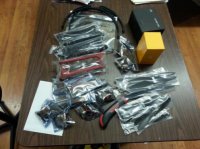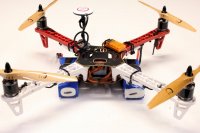I was in the shop this afternoon and I couldn't help but put the props on, a couple of batteries, and fire it up. It's alive! It's ready to fly at this point but I'm going to go through the manual, review each step and make sure I've done everything that needs to be done. With the GPS mounted there is a compass calibration that has to be done and probably one or two other things before it can be flown. Here are a couple of photos and then we're going to hunker down for a review of the manual.
I'm going to be letting the batteries act as my landing gear with the FPV camera up on top of the frame along with the video transmitter which will both be added after it flies.
Looking at the DJI NAZA Manual, page 3 kicks things off by saying that DJI isn't responsible for what you do with the product you've bought and are about to take airborne. You can't really blame them as it does represent a certain amount of risk. To that end, understand that you can hurt someone by flying your new helicopter so you've got to be careful and methodical as you learn to fly it and in the future as you attempt to expand your operating envelope. If at any time you aren't sure what is happening or why it's doing something odd,
stop and ask for help. It's that easy and there are plenty of people here and elsewhere that would rather help you than see you crash.
If at this point you still have questions about the different parts or how they're hooked up to each other, those questions can be answered on pages 5 and 6.
Page 7 is important because it explains the correct sequence to connect the NAZA to the computer. Remember, there's a radio (Tx), a flight control system, a USB connection, and a laptop with proprietary software which all need to be powered up and hooked up in the correct sequence to make the connection function. Basically the sequence is to first power up your laptop, then the Radio transmitter, then the helicopter flight battery (REMOVE YOUR PROPS FIRST OR A CERTAIN MODERATOR WILL VISIT YOU AT YOUR HOME TO DELIVER A STERN WARNING! AND NO HE WON'T BRING BEER), attach the NAZA to the computer with the USB cable, and then open up the NAZA Assistant software. The NAZA Assistant should connect to the NAZA flight control system and display whatever setting have already been established. If the firmware is old of if the firmware in in conflict with the versin of the Assistant that you are running then you will immediately get a message. The first time you do all of this the Assistant will attempt to register your NAZA system along with the serial number and some basic account information for you.
Page 8 shows some recommended starting settings for your gains. Gains are settings that dictate how well the helicopter flies and by being able to set these gains for our individual helicopters we have more freedom to customize our aircraft.
Page 9 discusses Control Mode Knowledge and I commend DJI for taking the time to dream up this detailed bit of information but if I were looking at it for the first time as a new owner/pilot I'd be confused. It's basically trying to explain what features are available in what modes.
- Manual mode means that if you roll or pitch the helicopter and then center the stick, the helicopter won't necessarily return to a level flight condition by itself and it may go sailing of into a tree or building if you don't make an effort to control the aircraft's attitude manually. You're on your own with manual mode and things can get out of control in a hurry so don't be too heavy thumbed on the controls. Use small inputs to get a feel for response and control.
- In ATTI mode the various sensors in the flight controller are assisting you by returning the helicopter to a level condition when you center the sticks on the transmitter. It can still go sailing off into a tree but it likely won't happen as quickly or with the same complete loss of control that can happen in Manual mode. Some other flight control systems call this type of assisted mode, Auto-level which is a more intuitive term as the helicopter is literally leveling itself automatically when you release the sticks.
- GPS ATTI mode uses the GPS receiver to hold the helicopter in one spot over the ground. While in this mode you can move the sticks and the helicopter will respond but when you let go the heli will attempt to take up residence right where you left it and it will stay there until the batteries die
At the bottom of page 8 and into pages 9 and 10 are the motor stop and start directions. Various flight controllers use a variety of tricks to get the motors spinning, most of these tricks are in the name of safety as it is easy to bump the sticks inadvertently while futzing around before a flight. By making it necessary to do some combination of stick inputs to "arm" the motors they have reduced the possibility of the motors spinning up unexpectedly which could hut someone.
Skip page 11 if you don't have the GPS module. If you do have the GPS module then you need to follow these instructions to calibrate the compass sensors. Follow the directions very closely as this step will contribute to how well your heli flies and does its thing with the different features.
Read page 14 before proceeding through pages 12 and 13 and certainly before your first flights.
In pages 12 and 13 DJI is beginning to get a little nervous that you might have actually made it that far and will possibly fly your new multi-rotor helicopter. They ask you to double check some basic things that can ruin your first flight so I'd say it's worth reviewing their list of items and make sure you're in compliance with them. When you first power up the helicopter, try to keep it as perfectly still as possible as the sensors will be initializing themselves. Follow the directions here and you should be good to go!
Page 15 is important because DJI is trying to explain how the built in Fail-Safe feature works and what it will do when activated. If you know what it will do then you have a better chance of not panicking should it ever happen to you. I'd recommend reading this page even if it doesn't make much sense at first. It will begin to make sense if you keep going back to it and keep trying to soak up what they're laying down.

Regarding page 16, the general consensus amongst DJI users (IMHO) is that their flavor of low voltage protection isn't as awesome as the guy that designed it probably thinks it is. You may try it, you may not, it's a personal decision. Read up on it, ask some questions around the interweb and see for yourself if you think it has value.
Pages 17, 18, and 19 describe advanced flight control modes. These pages are fairly self explanatory but we're here if you have any questions.
On page 20 they discuss the Receiver Advanced Protection function. I'm not entirely familiar with this and in reading it I'm just more confused. We can discuss this in the NAZA sub-forum...
http://www.multirotorforums.com/sho...anced-Protection-function&p=142409#post142409
The next page that really jumps out at me is page 23 as it explains the various LED color and flashing pattern combinations. IT'S A GREAT IDEA TO PRINT THIS OUT IN COLOR AND STUFF IT IN YOUR BACK POCKET WHEN YOU GO FLYING. You should have built your heli so you could see the NAZA's LED when it's flying. These flashing patterns are confusing because there are so many possibilities and when you're out at the flying field or your local park it's nice to have page 23 available if things don't look quite right.
That's it for now. I'll continue in another post in the morning!
Thanks for reading,
Bart





